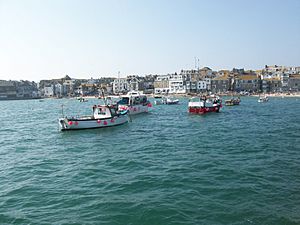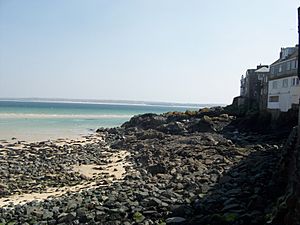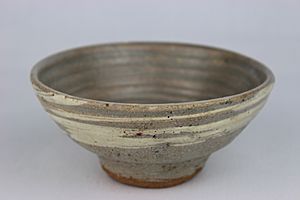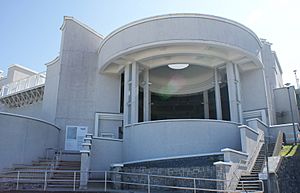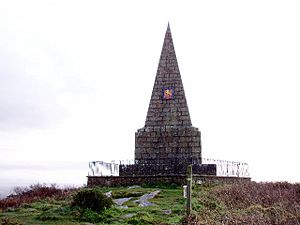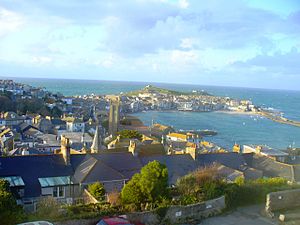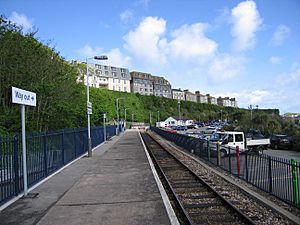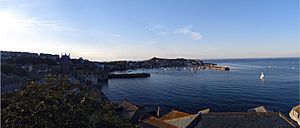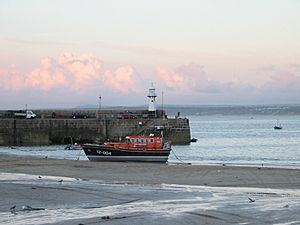St Ives, Cornwall facts for kids
Quick facts for kids St Ives
|
|
|---|---|
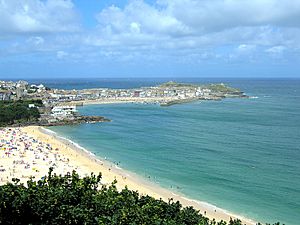 St Ives Harbour and Porthminster Beach |
|
| Lua error in Module:Location_map at line 530: Unable to find the specified location map definition: "Module:Location map/data/Cornwall (mainland)" does not exist. | |
| Population | 11,226 United Kingdom Census 2011 |
| OS grid reference | SW518403 |
| Civil parish |
|
| Unitary authority | |
| Ceremonial county | |
| Region | |
| Country | England |
| Sovereign state | United Kingdom |
| Post town | ST. IVES |
| Postcode district | TR26 |
| Dialling code | 01736 |
| Police | Devon and Cornwall |
| Fire | Cornwall |
| Ambulance | South Western |
| EU Parliament | South West England |
| UK Parliament |
|
St Ives (Cornish: Porth Ia, meaning "St Ia's cove") is a seaside town, civil parish and port in Cornwall, England. The town lies north of Penzance and west of Camborne on the coast of the Celtic Sea. In former times it was commercially dependent on fishing. The decline in fishing, however, caused a shift in commercial emphasis, and the town is now primarily a popular seaside resort, notably achieving the title of Best UK Seaside Town from the British Travel Awards in both 2010 and 2011. St Ives was incorporated by Royal Charter in 1639. St Ives has become renowned for its number of artists. It was named best seaside town of 2007 by The Guardian newspaper.
Contents
History
Early history
The origin of St Ives is attributed in legend to the arrival of the Irish saint Ia of Cornwall, in the 5th century. The parish church bears her name, and St Ives derives from it.
The Sloop Inn, which lies on the wharf was a fisherman's pub for many centuries and is dated to "circa 1312", making it one of the oldest inns in Cornwall. The town was the site of a particularly notable atrocity during the Prayer Book Rebellion of 1549. The English provost marshal, Anthony Kingston, came to St Ives and invited the portreeve, John Payne, to lunch at an inn. He asked the portreeve to have the gallows erected during the course of the lunch. Afterwards the portreeve and the Provost Marshal walked down to the gallows; the Provost Marshal then ordered the portreeve to mount the gallows. The portreeve was then hanged for being a "busy rebel".
The seal of St Ives is Argent, an ivy branch overspreading the whole field Vert, with the legend Sigillum Burgi St. Ives in Com. Cornub. 1690.
During the Spanish Armada of 1597 two Spanish ships, a bark and a pinnace had made their way to St Ives to seek shelter from the storm which had dispersed the Spanish fleet. They were captured by the English warship Warpsite of Sir Walter Raleigh leaking from the same storm. The information given by the prisoners was vital on learning the Armada's objectives.
Fishing
From medieval times fishing was important at St Ives; it was the most important fishing port on the north coast. The pier was built by John Smeaton in 1767–70 but has been lengthened at a later date. The octagonal lookout with a cupola belongs to Smeaton's design.
In the decade 1747–1756 the total number of pilchards dispatched from the four principal Cornish ports of Falmouth, Fowey, Penzance, and St Ives averaged 30,000 hogsheads annually (making a total of 900 million fish). Much greater catches were achieved in 1790 and 1796. In 1847 the exports of pilchards from Cornwall amounted to 40,883 hogsheads or 122 million fish while the greatest number ever taken in one seine was 5,600 hogsheads at St Ives in 1868.
A. K. Hamilton Jenkin describes how the St Ives fisherman strictly observed Sunday as a day of rest. St Ives was a very busy fishing port and seining was the usual method of fishing. Seining was carried out by a set of three boats of different sizes, the largest two carrying seine nets of different sizes. The total number of crew was seventeen or eighteen. However this came to an end in 1924. The bulk of the catch was exported to Italy: for example, in 1830, 6400 hogsheads were sent to Mediterranean ports. From 1829 to 1838, the yearly average for this trade was 9000 hogsheads.
While commercial fishing is much reduced, the harbour is still in use, often as well for recreational boating, tourist fishing and day trips to the nearby seal colonies on the Carrack Rocks and other locations along the coast. Recently, a class of Victorian fishing boat unique to St. Ives, known as a "jumbo," has been replicated by boatbuilder Jonny Nance to celebrate the town's maritime heritage. Today's jumbos are operated by the St. Ives Jumbo Association.
Lifeboat
The first lifeboat was stationed in the town in 1840. In 1867 the Royal National Lifeboat Institution built a boathouse at Porthgwidden beach. It proved to be a difficult site to launch from and in 1867 it was replaced by a building in Fore Street. In 1911 a new boathouse was built on the Quay, and then in 1993 a larger station was built at the landward end of the West Pier.
Seven crewmen died in the St Ives lifeboat tragedy of 1939. In the early hours of 23 January 1939 there was a Force 10 storm blowing with gusts up to 100 miles per hour (160 km/h). The lifeboat John and Sara Eliza Stych was launched at 3 o'clock to search for a ship reported in trouble off Cape Cornwall. It rounded The Island where it met the full force of the storm as it headed westwards. It capsized three times and drifted across St Ives Bay when its propeller was fouled. The first time it turned over four men were lost; the second time one more; the third time left only one man alive. He scrambled ashore when the boat was wrecked on rocks near Godrevy Point.
Later history
The modern seaside resort developed as a result of the arrival of the St Ives Bay branch line from St Erth, part of the Great Western Railway in 1877. With it came a new generation of Victorian seaside holidaymakers. Much of the town was built during the latter part of the 19th century. The railway, which winds along the cliffs and bays, survived the Beeching cuts and has become a tourist attraction itself.
In 1999, the town was the first landfall of the Solar eclipse of August 11, 1999. A live BBC programme with Patrick Moore was clouded out and the eclipse was missed.
Sharks
On 28 July 2007 there was a suspected sighting of a great white shark. The chairman of the Shark Trust said that "it was impossible to make a conclusive identification and that it could have also been either a Mako or a Porbeagle shark". Coastguards dismissed the claims as "scaremongering". On 14 June 2011 there was a suspected sighting of an oceanic whitetip shark, after a boat was reportedly attacked. The Shark Trust said that the chances of the species being in British waters were "very small".
Geography
St Ives is situated on the western shore of St Ives Bay, its harbour sheltered by St Ives Island (a headland) and Smeaton's pier. Close to the harbour, its streets are narrow and uneven while its wider streets are in the newer parts of the town on rising ground. The town has four beaches: Porthmeor a surfing beach, Porthgwidden a small sandy cove, Harbour by the working port and Porthminster which has almost half a mile of sand. St Ives has an oceanic climate and has some of the mildest winters and warmest summers in Britain and Northern Europe. It is therefore a popular tourist resort in the summer, and also benefits from an amount of sunshine per year that is above the national average. The South West Coast Path passes through the town.
Religion
The parish church is dedicated to Saint Ia of Cornwall, an Irish holy woman of the 5th or 6th century, and St Andrew, the patron saint of fishermen. In 1408 the townsmen attempted to get a papal bull to authorise the consecration of their church and cemetery, but they did not achieve this, so they continued without the rights of baptism or burial. However, they undertook the building of the present church between 1410 and 1434 as a chapel of ease, St Ives being within the parish of Lelant. They were able to obtain the right to a font in 1428 but consecration of the cemetery only in 1542. For over a century the vicars of Lelant had resisted demands from the inhabitants of St Ives and Towednack for the right of sepulture but in 1542 the right was granted so the vicars transferred their residence to St Ives and abandoned the vicarage of Lelant. There was damage to the church in 1697 when a storm broke through the sea-wall and damaged the roof and a large window over the altar. There are chapels dedicated to St Nicholas on the headland of St Ives Island and St Leonard on the quay which were used by the fishermen and have been converted for other uses. The former chapel of St Nicholas was partially demolished by the War Office in 1904 but rebuilt in 1909, possibly by E H Sedding, from the old materials. It is plain and rectangular and has since been converted into the New Gallery.
The Roman Catholic Church of the Sacred Heart and St Ia was built in 1909 to a design by A J C Scoles. There are also two Methodist chapels, one in Fore Street of 1831, and another of 1845 higher up the valley, and a Congregational chapel of 1800.
Culture
Art
Bernard Leach and Shōji Hamada set up the Leach Pottery in 1920. Leach was a studio potter and art teacher, and is known as the "Father of British studio pottery", learned pottery under the direction of Shigekichi Urano (Kenzan VI) in Japan where he also met Shōji Hamada. They promoted pottery from the point of view of Western and Eastern arts and philosophies. Leach produced work until 1972, and the Victoria and Albert Museum held an exhibition of his work in 1977. The Leach Pottery remains operational and houses a small museum showcasing work by Leach and his students.
In 1928, the Cornish artist Alfred Wallis and Ben Nicholson and Christopher Wood met at St Ives and laid the foundation for the artists' colony. In 1939, Ben Nicholson, Barbara Hepworth and Naum Gabo settled in St Ives, attracted by its beauty. In 1993, a branch of the Tate Gallery, the Tate St Ives, opened. The Tate looks after the Barbara Hepworth Museum and her sculpture garden. The town attracted artists from overseas, such as Piet Mondrian and Maurice Sumray, who moved from London in 1968, and continues to do so today with younger artists such as Michael Polat, who took up residence there from his native Germany in 1999.
Before the 1940s, most artists in St Ives and West Cornwall belonged to the St Ives Society of Artists; but events in the late 1940s led to a dispute between the abstract and figurative artists in the group. In 1948 the abstract faction broke away to form the Penwith Society of Artists led by Barbara Hepworth and Ben Nicholson.
In 1962 Frederick Spratt took a sabbatical in England for one year, where he lived and painted representationally in St Ives.
The studio pottery Troika was set up in 1963.
A 2010, a BBC4 film, The Art of Cornwall, presented by James Fox said that the St Ives artists' "went on to produce some of the most exhilarating art of the twentieth century...for a few dazzling years this place was as famous as Paris, as exciting as New York and infinitely more progressive than London." The programme explored the lives and works of the key figures and their contributions in establishing St Ives as a major centre of British art from the 1920s onwards.
Museums
The Barbara Hepworth Museum and her sculpture garden are the responsibility of Tate St Ives. It was the wish of the late sculptor to leave her work on public display in perpetuity. The St Ives Museum has exhibits illustrating local history and culture, including mining, fishing, agriculture and domestic life.
Festivals
John Knill, a former mayor, constructed the Knill Steeple, a granite monument overlooking the town. In 1797, Knill laid down instructions for the celebration of the Knill Ceremony, which was to take place every five years on 25 July (St James's Day). The ceremony involves the Mayor of St Ives, a customs officer, and a vicar accompanied by two widows and ten girls who should be the "daughters of fishermen, tinners, or seamen".
A second celebration, of perhaps greater antiquity, is St Ives Feast, a celebration of the founding of St Ives by St Ia, which takes place on the Sunday and Monday nearest to 3 February each year. It includes a civic procession to Venton Ia, the well of St Ia, and other associated activities. It is one of the two surviving examples of Cornish Hurling (in a gentler format than its other manifestation at St Columb Major).
A third festival is the St Ives May Day, a modern revival of West Cornwall May Day celebrations that were once common throughout west Cornwall.
The St Ives September Festival celebrated its 30th anniversary in September 2008. It is one of the longest running and widest ranging Festivals of the Arts in the UK lasting for fifteen days and includes music (folk, jazz, rock, classical & world), poetry, film, talks and books. It was founded in 1978 as a joint venture by local entrepreneurs and the International Musicians Seminar. Many local artists open up their studios to allow visitors to see how their art is produced. There is free music in many pubs almost every night, and concerts. Many events are held at the Western Hotel or St Ives Guildhall. St Ives has a 500-seat theatre which hosts some of the festival events.
Literature and popular culture
St Ives is well known from the nursery rhyme and riddle "As I was going to St Ives", although it is not clear whether the rhyme refers to the Cornish town or one of several other places called St Ives.
St Ives figures in Virginia Woolf's reflections contained in "A Sketch of the Past", from Moments of Being:
...I could fill pages remembering one thing after another. All together made the summer at St. Ives the best beginning to life imaginable.
Her 1927 novel To the Lighthouse is said to have been influenced by the view from Talland House where she stayed with her parients on family holidays.
The Cornish language poet Mick Paynter is resident in St Ives.
The Discovery Travel and Living programme Beach Café is filmed in St Ives, featuring Australian chef Michael Smith.
Sue Limb's Girl, (Nearly) 16: Absolute Torture is partly set in St Ives.
The Ulysses Moore series of books, written by Pierdomenico Baccalario are based in the hypothetical village of Kilmore Cove near Zennor and St Ives.
In the film Monty Python and the Holy Grail, Sir Lancelot (John Cleese) asks if there's a "St. Arrrrghs" in Cornwall, to which King Arthur (Graham Chapman) replies, "No, that's St. Ives".
Transport
St Ives railway station is linked to the Paddington to Penzance main rail route via the St Ives branch line which runs frequent services from St Erth. The line was opened in 1877 by the St Ives branch railway, but became part of the Great Western Railway in 1878. Before 2019, the park & ride facility for visitors to St Ives ran from Lelant Saltings railway station. The station had been opened on 27 May 1978 specifically for this purpose. After development works at St Erth station in 2019 to improve transport links, the park and ride was moved there. The branchline also links the St Ives to nearby Carbis Bay and Lelant.
The town also has regular services by National Express coaches from London Victoria Coach Station, Heathrow and other places in Britain. First Kernow buses also connect St Ives to nearby towns and villages, such as Zennor, Penzance and Truro.
The nearest airports to St Ives are Newquay and Land's End Airport, near St Just. Private jets, charters and helicopters are served by Perranporth Airfield.
Twinning
St Ives is twinned with Camaret-sur-Mer (Breton: Kameled) in Brittany, France.
On Sunday 7 September 2014, St Ives had a ceremony to make St Ives and Laguna Beach, California, US a Sister City.
Sport
St Ives is the home of St Ives Rugby Football Club (founded 1889) who play at the Recreation Ground on Alexandra Road. Once one of the dominant clubs in Cornish rugby, they currently play in Tribute Western Counties West league, (tier 7 of the English rugby union system). There is also a football team, St Ives Town F.C., who play in the Cornwall Combination (division 12 of the English football system). Their ground is at Lelant Saltings.
Notable people
Before 1900
- Rev. Thomas Tregosse (c. 1600 in St Ives – c. 1670) Puritan minister who was silenced for being a Nonconformist
- Jonathan Toup (1713 in St Ives – 1785) English philologist, classical scholar and critic
- John Knill (1733 in Callington – 1811) slightly eccentric mayor of St Ives and Collector of Customs at St Ives from 1762 to 1782
- James Halse (1769 – 1838) English lawyer, wealthy businessman and Tory (later Conservative) politician. Settled in St Ives in 1790.
- John Baragwanath (1817 in St Ives – 1885) miner and politician in Australia, member of Victorian Legislative Assembly
- Richard Short (1841 in St Ives – 1919) was a Cornish artist; the Museum of Wales holds five of his works.
- Sir Edward Hain (1851 in St Ives – 1917) shipping owner, MP for St Ives as a Liberal Unionist 1900/04, and as a Liberal 1904/06
- John Noble Barlow (1861–1917) English artist, predominantly as a landscape and seascape painter, lived in St Ives from 1892.
- Percy Lane Oliver (1878–1944) from St Ives was the founder of the first voluntary blood donor service in 1921.
- Virginia Woolf (1882–1941) English novelist, spent much of her childhood here with her family between 1882 and 1894.
- Warwick Ward (1891 in St Ives – 1967) English actor and film producer, appearing in 64 films between 1919 and 1933; he produced 19 films between 1931 and 1958.
Since 1900
- Mabel Lethbridge BEM (1900–1968) Youngest person to receive a British Empire Medal, after she was severely injured when a shell exploded in a munition factory in the Great War. Lived in St Ives from 1945 as a writer.
- Barbara Hepworth DBE (1903–1975) English Modernism artist and sculptor. Lived and worked in St Ives from 1949.
- Sven Berlin (1911–1999) English painter, fiction writer and sculptor, lived and worked in St Ives from 1938 to 1953.
- George Lloyd (1913 in St Ives – 1998) was a British composer of part Welsh and part American ancestry.
- Margaret Mellis (1914–2009) British artist, one of the early members and last survivors of the group of modernist artists in St Ives
- Bryan Wynter (1915 – 1975) one of the St Ives group of painters, working mainly abstract, drawing upon nature
- Peter Lanyon (1918 in St Ives – 1964) a Cornish painter of landscapes, leaning heavily towards abstract art
- Patrick Heron (1920 – 1999) British abstract and figurative artist, lived in Zennor.
- William Marshall (1923 in St Ives – 2007) English studio potter who joined the Leach Pottery
- Bryan Pearce (1929 in St Ives – 2007) British painter. He was recognised as one of the UK's leading naïve artists.
- John Nott KCB (born 1932) former British Conservative Party MP for St Ives from 1966 to 1983, Secretary of State for Defence during the Falkland war, now lives on his farm at St Erth
- David Harris (born 1937), British Conservative Party MP for St Ives from 1983 to 1997
- Jennifer Gretton, Baroness Gretton (born 1943 in St Ives), Lord Lieutenant of Leicestershire from 2003 to 2018
- Mick Paynter (1948), Grand Bard of Cornwall, retired civil servant, trade union activist, and poet
- Anthony Frost (born 1951 in St Ives) English painter noted for his abstract works consisting of brightly coloured prints and collages
- Andrew George (born 1958 in Mullion) British Liberal Democrat politician and MP for St Ives from 1997 to 2015
- Fleur Bennett (born 1968 in St Ives) British television actress, known for her work in 'Grace and Favour'
- Fink, aka Fin Greenall (born St Ives 1972), English singer, songwriter, guitarist, producer and DJ
Images for kids
See also
 In Spanish: St Ives (Cornualles) para niños
In Spanish: St Ives (Cornualles) para niños


